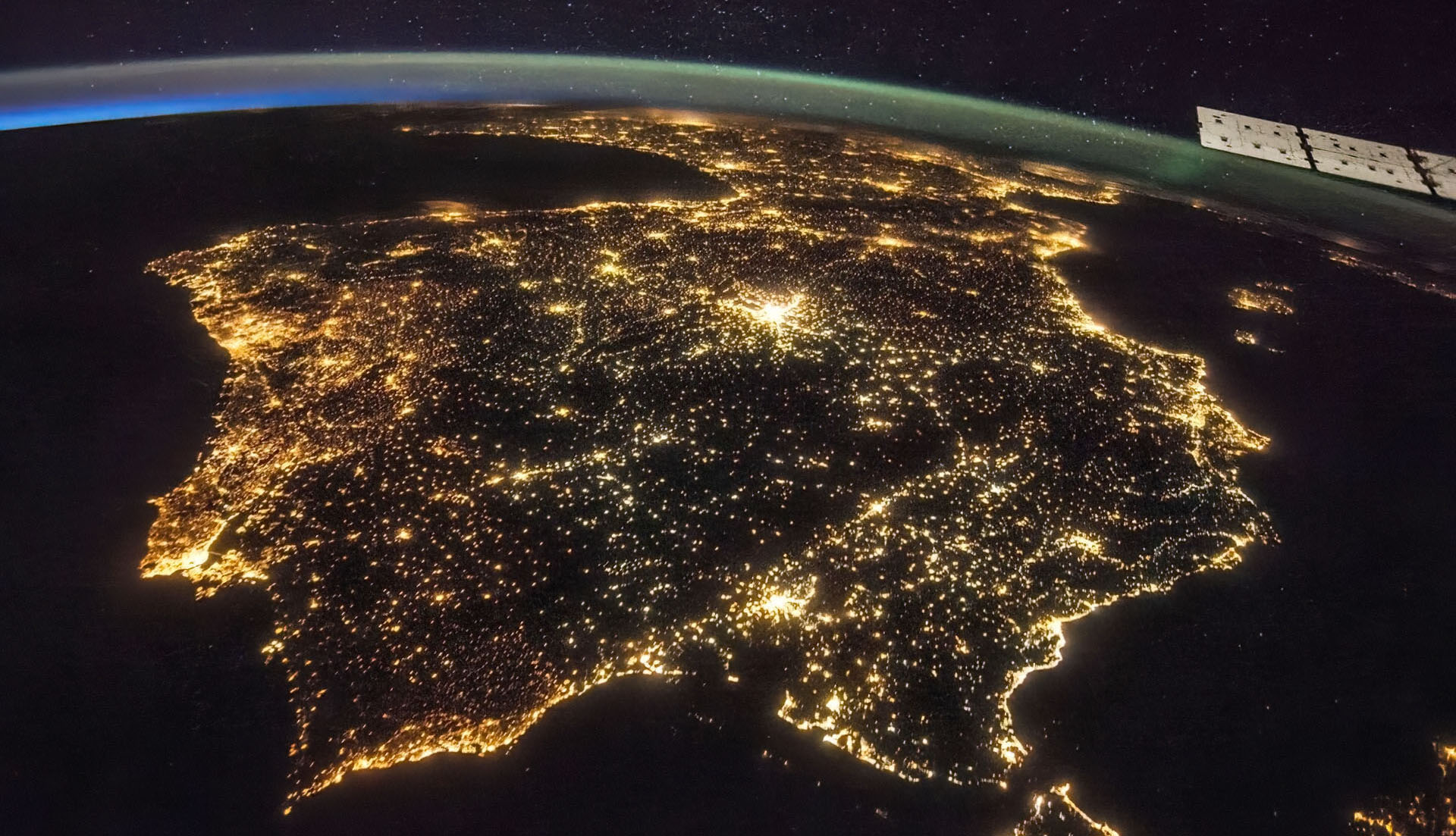
The evolution of mankind has historically led to pollution of the world around him in its various forms. The first traces of human-caused pollution date back more than 5,600 years, when humans began working bronze in the Balkan region of south-eastern Europe. Although there are traces that the Sumerians, 4,000 years BC, were already working metals.
Humans, as the material transformers that they are, cause various forms of pollution in their environment.
But it is only in recent decades, more than 5,000 years after the first clear traces of pollution were found, that we have begun to think about the impact of our work and our actions on the environment around us.
What is light pollution?
Light pollution is one of the various forms of pollution produced by humans.
Light pollution is the pollution of the environment caused by artificial lighting systems used by humans.
Light at night is natural. The night is not totally dark, but the moon itself, the stars and even the Milky Way bathe the environment with their light in varying intensities. These natural sources of nocturnal light have shaped the evolution of terrestrial life forms, animals and plants. In fact, many animals and plants regulate their reproductive cycles or nocturnal activity according to the lunar cycle.
For this reason, the intrusion of artificial light into ecosystems ends up altering these natural cycles, causing many species to modify their biological rhythms or even disappear from the environment or become seriously threatened. This could be the case of sea turtles, which lay their eggs on certain beaches around the world. When the eggs hatch, the first instinct of the turtle hatchlings is to head towards the points of light, as they are trained to identify these points of light, which in a natural environment would correspond to the light of the moon reflected in the sea. However, the result is quite different and many sea turtle hatchlings die at the end of the year, confused by the artificial lights of cities.
But light pollution is not just a problem that affects the environment around us. It is also a direct threat to human beings.
Melatonin is a hormone produced by our body, the amount of which depends on the amount of light around us. As naturally diurnal beings, our bodies are designed to wake up and stay active during the daylight hours of the day, and to start switching off various functions and prepare for sleep during the hours of darkness. Melatonin plays an essential role in this natural process.
Light pollution in the environment around us alters the production of melatonin in our body, disrupting our sleep cycle, causing short-term problems of insomnia, fatigue or stress, and in the longer term increasing the risk of diseases such as diabetes or cancer.
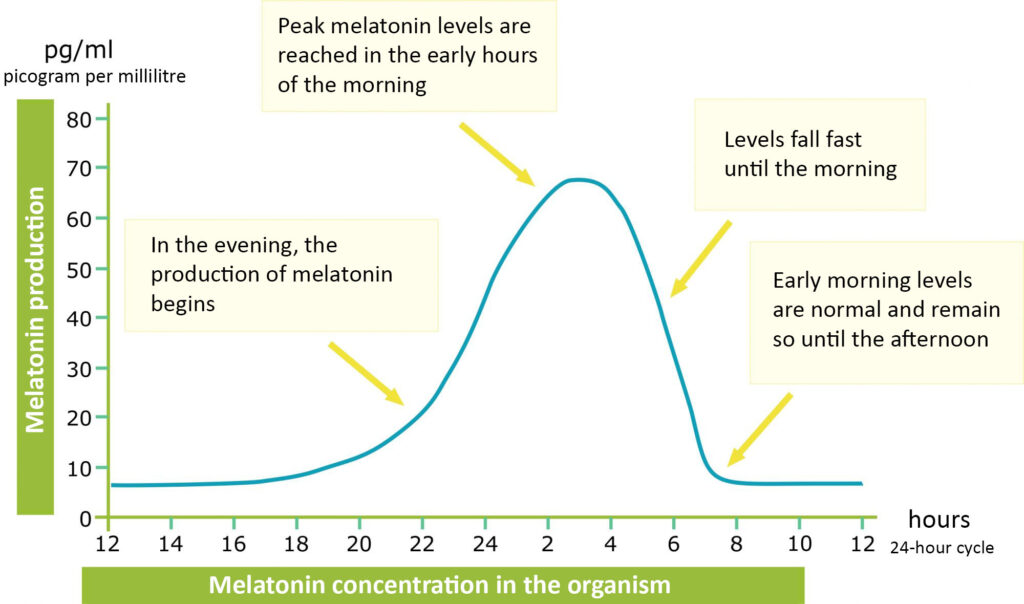
But beyond the direct effects of light pollution on the environment around us or on ourselves, light pollution is also an economic problem.
It is estimated that, on average, 30% of the electrical energy produced on our planet is needlessly discharged into the sky. The use of inefficient luminaires, with inadequate tilt, and unregulated and non-standardised light intensities produce significant economic losses. And this problem is even greater in large cities.
Ultimately, light pollution is also the type of environmental pollution that most affects astronomers and astrophysicists, both amateur and professional.
In the past, when the level of light pollution was much lower than it is today, it was common to find several professional astronomical observatories located inside some cities. These observatories are nowadays in complete disuse and are only preserved as museums, not only because they have obsolete instrumentation, but also because the level of light pollution in these cities does not allow any kind of scientific application with these instruments.
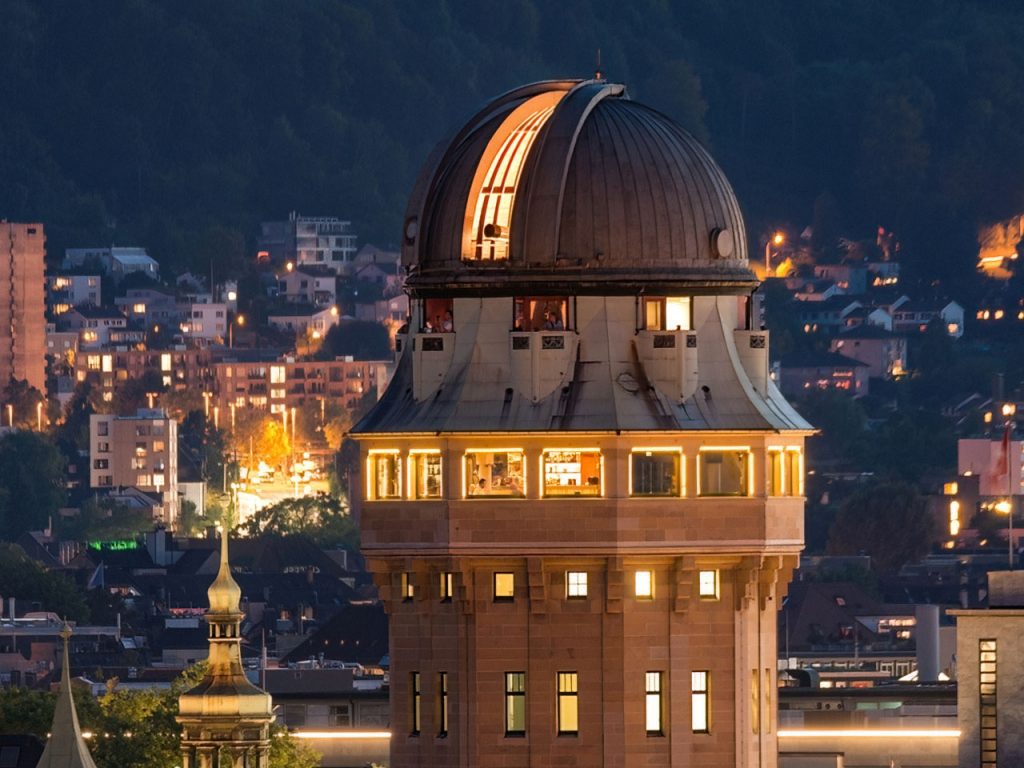
Professional astronomical observatories have been retiring to remote environments, far from urban centres that emit light pollution, and in some cases even enjoying exclusive regulation of public and private lighting in the urban centres of the region, as is the particular case of the island of La Palma, in the Canary Islands (Spain).
At the amateur level, light pollution is a problem that amateurs all over the world have to struggle with. From travelling to remote places in search of less light-polluted skies to develop their astronomical or astrophotographic observation sessions, to the use of specific filters capable of counteracting part of the light pollution present in cities, of course sacrificing an important amount of information from the Universe in their observations.
One of the latest options being considered by a large percentage of astronomy and especially astrophotography enthusiasts worldwide is to install astronomical equipment in telescope hostings. Telescope hostings are facilities located in environments specially selected for the quality of their night sky. These facilities offer the user all the necessary infrastructure so that he can install his astrophotographic equipment there and control it from his home or from the place he considers appropriate in exchange for a rental fee.
If you want to find out more about how hosting and renting space works, we recommend you visit the Cosmoescape Remote Telescopes website.
So in short, light pollution is one of the most unnoticed forms of pollution produced by humans. However, it is no less harmful, and as we have seen, it not only affects the environment around us, but can also seriously affect our own health and our economy.
How is light pollution measured?
So far we have reviewed what light pollution is and how it affects the environment and our lives in different ways.
But we cannot talk about light pollution without having a method to measure and quantify it.
At an amateur level and paying attention to the astronomical and astrophotographic aspect, there are several ways to measure or estimate the light pollution of a place.
The most common measurement systems to determine the light pollution index of a site are the Bortle and SQM scales.
Bortle scale
It is probably the best known measurement system for quantifying the level of light pollution at a location. This scale was created by John E. Bortle, an American amateur astronomer who specialised in comet observation, although his fame is mainly due to the development of this measurement scale.
The Bortle scale measures the level of light pollution from 1 to 9, where Bortle 1 would be the total absence of light pollution, the level of light pollution we would find in the largest deserts or in the middle of the ocean, and Bortle 9 would be the level of light pollution we would find in megacities such as New York or Tokyo.
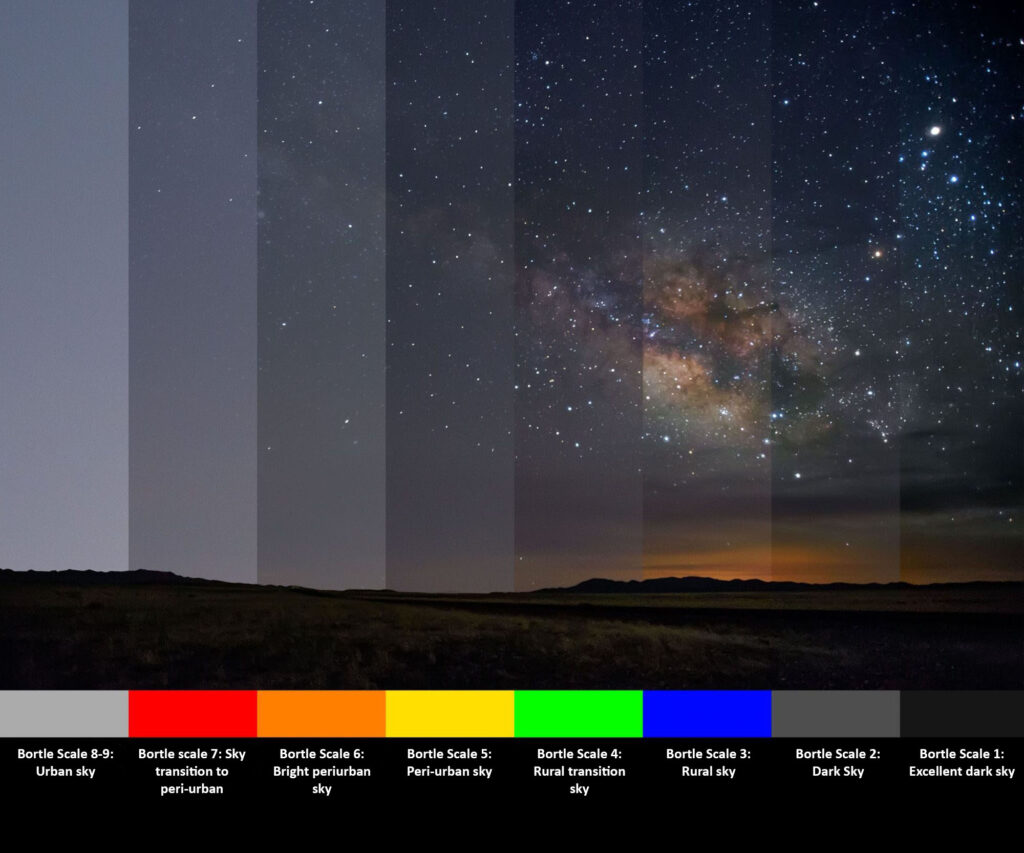
SQM scale
SQM stands for Sky Quality Meter, and in the case of SQM, unlike the Bortle scale, we are not just talking about estimates, but about direct measurements of the night sky. The Sky Quality Meter offers measurements on a logarithmic scale of magnitudes per arcsecond (MPSAS). Therefore in this case we do have direct and objective values measured directly on the night sky at a given location.
The SQM scale shows values between 16 and 22 MPSAS. Thus, values measured below 16 MPSAS would indicate a large amount of ambient light and a highly light-polluted sky. And a value of 22 MPSAS would indicate a sky with a zero level of light pollution.
By paying attention to these 2 scales for measuring the level of light pollution, there are several ways for amateurs to measure or estimate the quality of the sky at a given location.
Light Pollution Map
Light Pollution Map is possibly the most widespread and well-known option. Through the website https://lightpollutionmap.info we can access for free to a world map with estimates of night sky quality in Bortle and SQM scales, as well as other less widespread measurement systems.
Light Pollution Map works in many cases with estimates and approximations, so we can find slight differences between the quality of the night sky shown by the application and what we could measure objectively at a specific point. However, it receives regular updates that make the measurements provided by the website more reliable every day.
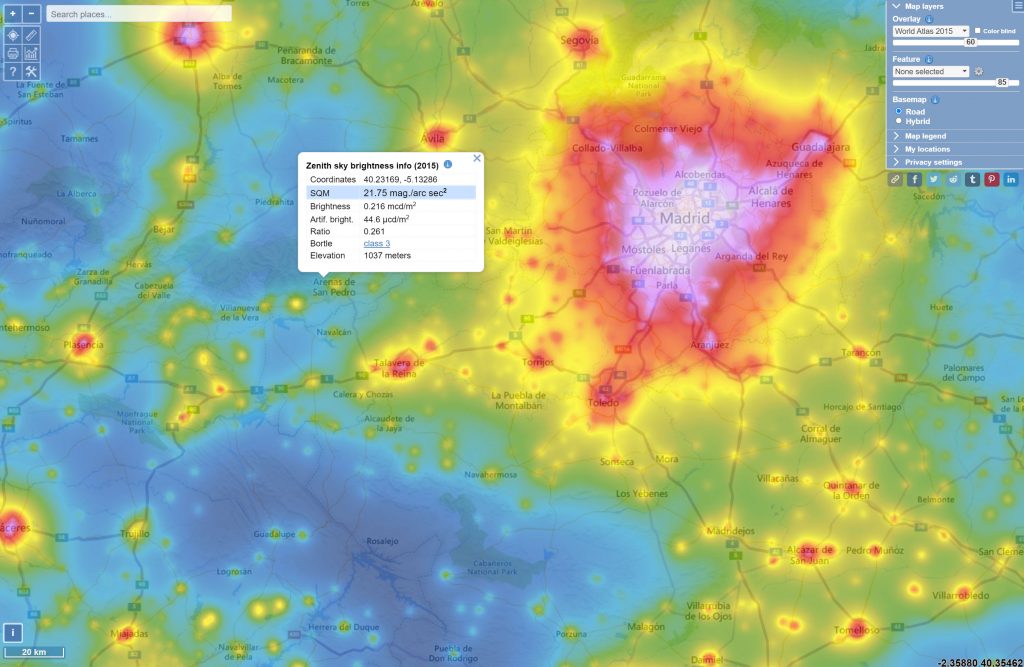
RALAN-Map EU Project
You can access it for free through the following link: https://pmisson.users.earthengine.app/view/sdgsat-1-p-iberica
This innovative project of Spanish origin has just been launched in December 2023 and for the moment only covers the Iberian Peninsula. However, it does so with a resolution never seen before, no less than 40m per pixel!
This project led by the astrophysicist Alejandro Sánchez de Miguel, from the Complutense University of Madrid, represents a significant advance in the study of light pollution, as it allows a deeper understanding not only of the impact on the environment, but also the impact on our health, showing how different types of light pollution affect us depending on the type of luminaire used and its colour.
SQM Meter
In this case we now enter the realm of actual night sky quality measurement.
SQM meters are relatively inexpensive items that allow us to have reliable MPSAS data measured in situ. With a series of these data we can establish an average that will indicate the quality of the night sky at the chosen location.
The different models of SQM meters differ mainly in the amount of sky they are able to cover. The L type, the cheapest ones, usually cover a portion of the sky of 20º, while the more advanced and professional ones can cover up to 80º. In this way we can get a more general picture of the quality of the night sky at the measured location..
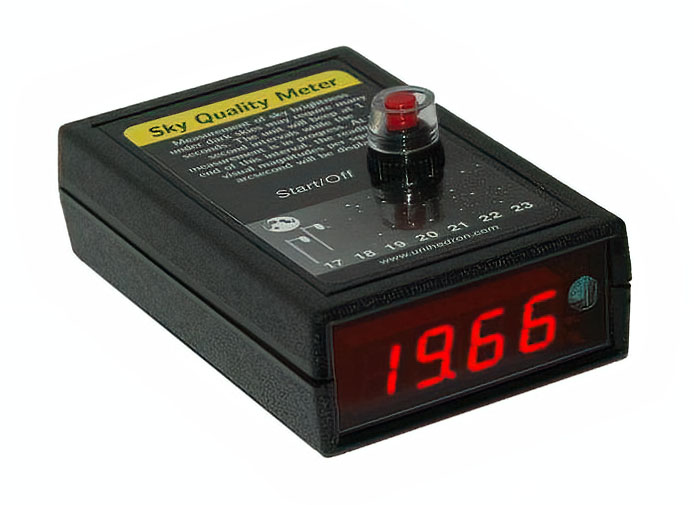
Uranus Meteo Sensor
This meter manufactured and marketed by the Pegasus brand takes the concept of night sky measurement one step further, and offers not only the possibility to measure the darkness of the sky in lux expressed in MPSAS, but also allows us to measure according to the Bortle scale. In addition, the Uranus Meteo Sensor includes a battery of extra gauges that turn it into something akin to a weather station. It has GPS, altitude, atmospheric pressure, humidity sensor, temperature, dew point calculation, cloud sensor and moon phase detection.
It is one of the best gauges to install in a fixed observatory or telescope hosting.
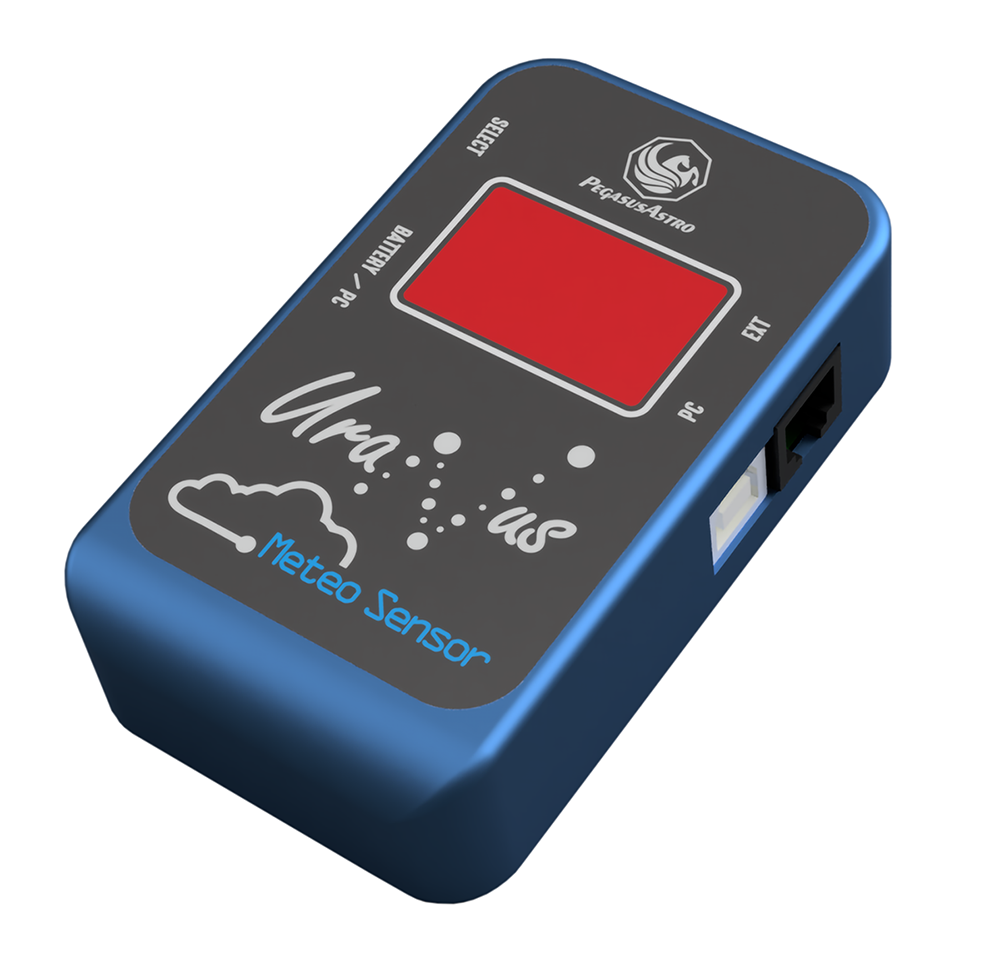
Is there a solution to the problem of light pollution?
As we have been seeing throughout this article, light pollution is one of the simplest environmental problems to solve, it would be enough to turn off artificial lights and it would disappear completely, but at the same time it is also one of the most complicated, since human beings need artificial light to develop our lives.
However, based on some experiments already carried out in certain population centres, just a series of adjustments made to public lighting would have an incredible positive impact on the amount of light discharged into the environment, and therefore on the level of light pollution.
Approved luminaires
Despite the length of time that the problem of light pollution has been studied, luminaires are still being installed and continue to be installed without the correct approval.
An approved luminaire is one that is designed so that the light it emits is directed towards the ground, so that it illuminates the surrounding environment and never shines upwards or sideways at an angle of more than 180º above the lamp itself.
The tilt and shielding of luminaires is key to meeting these requirements.

Number and intensity of lamps
The arrival of LED technology in our lives has brought with it many benefits, mainly those related to economy, since LED lamps consume much less energy than traditional lamps, and energy efficiency, i.e. with the same amount of LED lamps and lower energy consumption we can generate more intense lighting.
However, LED technology has also brought a negative side to these positive aspects: since lighting is now cheaper to produce, the number of lamps installed in urban areas has increased.
Therefore we now consume less energy but pollute more light.
Colour temperature
At the same time as the arrival of LED technology in cities, in a short period of time there has also been a replacement of luminaires in many population centres, moving from traditional luminaires to new LED luminaires. And in most cases this transition has been made from the characteristic amber colour of traditional sodium lamps to a white or even bluish tone that many of today’s LED lamps have.
Among the entire electromagnetic spectrum, it is blue light that is most easily scattered by the gases in our atmosphere. This is why the sky appears blue during the day.
But at night it is the same. White and bluish light scatters much more in our atmosphere than yellow or orange light. The result is that for the same light intensity, white or bluish light will produce much more light pollution than yellow or orange light.

Lack of common legislation
Finally, possibly one of the biggest problems when it comes to regulating the level of light pollution is the lack of legislation or a common consensus that establishes the guidelines for lighting all urban centres in the same country.
For example, some regions in Spain, such as the island of La Palma in the Canary Islands, have special lighting regulations, thanks to the presence of several astronomical and astrophysical research centres located on the island.
However, these regulations cannot be extended to other regions, leaving decisions on public lighting to local governments. The result is that, in the majority of cases, due to ignorance, non-approved, inadequate or inefficient luminaires are installed that do not provide the correct lighting and end up discharging a large percentage of the lighting they produce into the environment.
Only by paying attention to the points indicated in this article could the rate of light pollution be reduced by a very high percentage, which would be a very positive step towards finding a definitive solution to the problem of light pollution.
